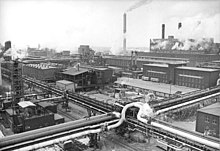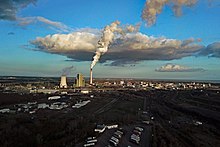Buna works
The Buna-Werke GmbH Schkopau were a chemical company for the polymeric plastic production. The company name BUNA is derived from the process for the production of synthetic rubber , the polymerization of butadiene with sodium - also known as Buna . Today the company is part of Dow Olefinverbund GmbH .
history
In order to achieve the independence of the economy in the National Socialist German Reich from the import of natural rubber , the foundation stone of the world's first synthetic rubber plant was laid in April 1936 under the name Buna-Werke GmbH Schkopau . The Buna works in Schkopau , between Merseburg and Halle (Saale) , were a subsidiary of the Ammoniakwerk Merseburg GmbH (later the Leunawerke ) belonging to IG Farben .
In 1937 the production of synthetic rubber began in Schkopau. The plant also produced polyvinyl chloride (PVC), trichloroethene , formaldehyde , tetrahydrofuran , acetic acid , acetic anhydride and acetone .
Wilhelm Biedenkopf , the father of the later politician Kurt Biedenkopf , was for a time the technical director of the Buna works.
On July 28, 1944, the plant in Schkopau was bombed for the first time (on the edge) by the American Air Force . The two most severe attacks took place on November 21st and 25th, 1944, a moderate attack on December 6th and a lighter one (aimed at the waterworks) on December 12th, 1944. Production was temporarily out of order. However, this was not discontinued until April 12, 1945.
During the Second World War, the Buna-Werke had a branch in Auschwitz (the Polish city of Oświęcim) , which was then annexed to Silesia , in which numerous forced laborers and concentration camp prisoners were employed. The Auschwitz-Monowitz concentration camp was built by IG Farben on the site of this branch. The Italian writer and chemist Primo Levi also performed forced labor there. The librettist and pop lyricist Fritz laborers-Beda , who in October 1942 to Auschwitz deported had been killed on 4 December of the same year the factory Auschwitz-Monowitz, where he wrote the Buna song .

On April 14, 1945, the Buna plant in Schkopau was occupied by the US Army , which was replaced by the Red Army in early July .
The original shareholders of Buna-Werke were expropriated without compensation. The company was converted into a Soviet stock corporation (SAG) by order of the Soviet occupation authorities . In 1954, the Buna chemical works belonging to SAG Kautschuk were transferred to a state-owned enterprise (VEB) of the GDR and became the VEB Chemical Works Buna combine . The Buna-Werke carried the advertising slogan “Plastics and elastics from Schkopau” , whereby plastics stand for thermoplastics and elastics for elastic plastics (synthetic rubber).
As Kombinat / VEB, the plant developed into the largest carbide producer in the world in 1958 . The technically outdated production facilities resulted in extreme environmental pollution.
With 18,000 employees, the Buna plant was one of the five largest industrial combines in the GDR. In order to cover the living space requirements for the workers and employees of the chemical works Buna and the Leuna works, prefabricated housing estates such as Halle-Neustadt and Halle-Silberhöhe were built in Halle, Merseburg and the surrounding area . They were connected to the works with their own S-Bahn lines.
After the fall of the Wall in 1989 , the Buna works were initially managed by the Treuhandanstalt . In 1995 the American company Dow Chemical took over large parts of the production facilities, but only a small number of employees. Much of the outdated production facilities were demolished and the floor was renovated. In 1997, the legal successor to the Treuhandanstalt, the Federal Agency for Unification-Related Special Tasks (BvS), expected the US group Dow Chemical to spend 809 million marks on the restructuring costs of the Buna Dow Leuna Olefinverbund GmbH.
The Schkopau plant has been part of Dow Olefinverbund GmbH since 2004 and produces on a petroleum basis using modern technical processes.
Lore
The written records of the Buna works from 1920 to 1990 are now kept in the Merseburg department in the Saxony-Anhalt state archive together with an extensive collection of photos . The holdings are named I 528 and I 529 .
literature
- Gabriele Ahlefeld, Astrid Molder, Rudolf Werner: Plastics and elastics from Schkopau. 60 years of Buna-Werke. Runkel, Pinneberg 1996, ISBN 3-9803386-5-7 .
- Dirk Hackenholz: The electrochemical works in Bitterfeld 1914–1945. A location of the IG-Farbenindustrie AG (= research on the latest history 3). LIT Verlag, Münster 2004, ISBN 3-8258-7656-X (also: Halle, Univ., Diss., 2004).
- Werner Schrader, Werner Franke: Small knowledge storage plastic. VEB German publishing house for basic industry, Leipzig 1970.
Web links
- History of the Buna-Werke Schkopau
- IG Farben receives the patent on BUNA, synthetic rubber ( Memento from July 15, 2009 in the Internet Archive )
- Information on the plastic and elastomer brand from Schkopau in the register of the German Patent and Trademark Office (DPMA)
- Documentation center for everyday culture in the GDR: alltagskultur-ddr.de
- Early newspaper articles on the Buna-Werke in the 20th century press kit of the ZBW - Leibniz Information Center for Economics .
Individual evidence
- ^ Text at Wollheim Memorial
- ↑ Birgit Wolf: Language in the GDR . Walter de Gruyter, 2000, ISBN 3-11-016427-2 .
- ↑ Der Spiegel from August 11, 1997: Buna subsidy hole
- ^ I 528 Buna Werke GmbH, Schkopau (1920-1954) in the State Archive of Saxony-Anhalt. Retrieved March 26, 2020 .
- ^ I 529 Kombinat VEB Chemische Werke Buna (1945-1990) in the State Archives Saxony-Anhalt. Retrieved March 26, 2020 .




